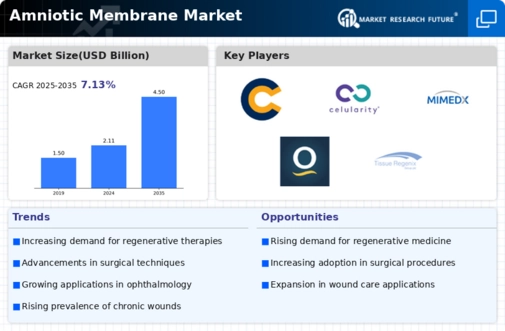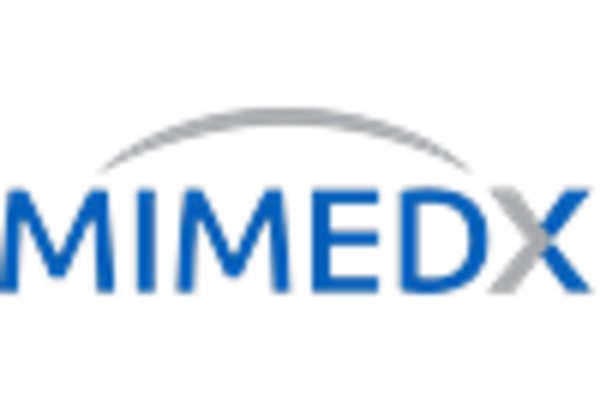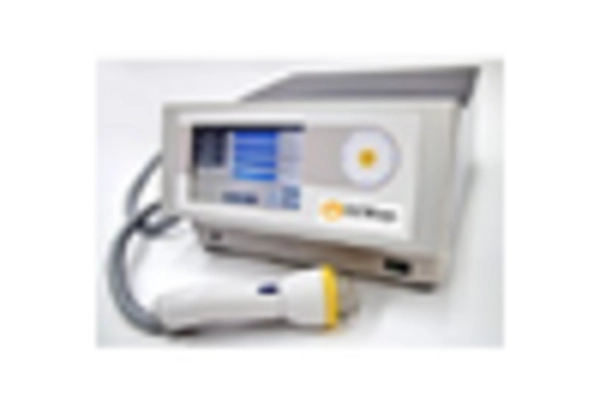Market Analysis
Amniotic Membrane Market (Global, 2024)
Introduction
The amniotic membrane market is set to evolve considerably, driven by the rapid development of regenerative medicine and an increased understanding of the therapeutic potential of amniotic tissues. The natural scaffold of the amnion is being increasingly used in a number of medical applications, including ophthalmology, wound healing and orthopedic surgery. The unique properties of the amniotic membrane, such as its anti-inflammatory and anti-scarring properties, are attracting the attention of clinicians and scientists, driving a proliferation of clinical trials and product developments. Furthermore, the increasing prevalence of chronic wounds and the increasing demand for minimally invasive surgical procedures are expected to increase the uptake of amniotic membrane products. The amniotic membrane market is expected to diversify further, with the introduction of new products and applications.
PESTLE Analysis
- Political
- In 2024, the regulatory environment for the amniotic membranes market will be strongly influenced by government policies aimed at improving the quality of health care. The Food and Drug Administration (FDA) has established new regulations for all amniotic membrane products, requiring all of them to undergo stringent clinical trials. It is estimated that up to 30 percent of the existing products will need to reapply for approval. The manufacturers are likely to be faced with higher costs for compliance. It is estimated that the average cost of clinical trials will be $2,6 million per product. The new international trade agreements, however, will help to open up access to the growing wound care markets in Europe and Asia.
- Economic
- In 2024, the economy was characterized by an increased demand for high-tech medical treatments, including those involving amniotic membranes. The global health budget was expected to reach about ten billion dollars, with a considerable share going to regenerative medicine. The average cost of an amniotic membrane graft was between a thousand and three thousand dollars, which made it a profitable option for hospitals seeking to improve the outcome of their patients. In the United States alone, it was estimated that over six million patients were affected by chronic wounds, which entailed considerable health costs.
- Social
- Social factors are expected to play a significant role in the amniotic membrane market in 2024, especially the increasing awareness of regenerative medicine among patients and medical practitioners. In the survey, about 70% of the doctors know the benefits of amniotic membrane therapy, which reflects the growing acceptance of advanced treatment methods. Patients also showed an increase of 25 percent in the demand for wound healing products. Awareness of these products has also led to the preference of patients for new treatment methods with better recovery outcomes.
- Technological
- The evolution of the amniotic membrane market in 2024 will be marked by technological innovations. Cryopreservation and lyophilization have improved the shelf life and effectiveness of amniotic membranes. Studies have shown that these methods can increase the viability of cells by up to 50%. Furthermore, the integration of digital health technology, telemedicine and electronic health records, is expected to facilitate the distribution and use of amniotic membranes, with an estimated 40% of hospitals adopting these systems to improve the follow-up of patients and the tracking of treatments.
- Legal
- In 2024 the regulatory framework governing the amniotic membranes trade tightens considerably. The new legislation provides for a more thorough labeling and tracing of all biological products. This is expected to affect more than 200 manufacturers in the United States alone. Intellectual property rights are also enforced more strictly. Over the past year, an estimated 150 patents have been filed for products based on amniotic membranes. This reflects the growing competition in the field and the need to protect innovation.
- Environmental
- In 2024, the amniotic membrane market is influenced more and more by the environment, especially regarding sustainable production and the disposal of waste. About 60% of the manufacturers already use biodegradable packaging and reduce the amount of waste in their production processes. Moreover, with the growing trend towards sustainability, guidelines have been developed that require companies to report on their impact on the environment. To meet these regulations, an estimated 30% of the companies in this industry have already invested in green technology. This is not only a matter of concern for the environment, but also a way to attract a growing number of consumers who are interested in the environment.
Porter's Five Forces
- Threat of New Entrants
- The market for amniotic membranes is moderately closed to new entrants due to the specialized knowledge and technology involved in the production and use of amniotic membranes. The market is growing, but new entrants may find it difficult to establish credibility and access distribution channels. However, as technology improves and the market grows, new players may enter the market.
- Bargaining Power of Suppliers
- Suppliers in the amniotic membrane market have low bargaining power because there are many sources for the raw materials and the technology needed for production. The presence of many suppliers reduces the dependence of the manufacturers on any one of them and enables them to obtain better prices and terms.
- Bargaining Power of Buyers
- High: Buyers in the amniotic membrane market, including hospitals and clinics, have a high degree of bargaining power because of the availability of alternative products and the increasing competition among suppliers. Since they are looking for cost-effective solutions, buyers can influence the price and the quality of the products they demand, thus putting pressure on the manufacturers.
- Threat of Substitutes
- The threat of substitutes to the amniotic membrane market is moderate, since there are alternative treatments and materials available for similar applications. However, the unique properties of amniotic membranes, such as their regenerative properties, limit the degree to which substitutes can be introduced. In the long run, however, constant developments in alternative treatments may increase this threat.
- Competitive Rivalry
- Competition in the Amniotic Membrane Market is High, with a number of established and new entrants vying for market share. Companies are focusing on promoting their products through aggressive marketing, product development, and strategic alliances. Competition in the market is driving the innovation, but it may also lead to price wars, affecting the overall profitability.
SWOT Analysis
Strengths
- High biocompatibility and effectiveness in wound healing.
- Growing acceptance in surgical procedures and ophthalmology.
- Advancements in processing techniques enhancing product quality.
Weaknesses
- Limited availability of donor tissues may restrict supply.
- High costs associated with processing and storage.
- Regulatory challenges and lengthy approval processes.
Opportunities
- Increasing prevalence of chronic wounds and eye disorders.
- Expansion of applications in regenerative medicine.
- Rising investments in research and development for innovative products.
Threats
- Competition from synthetic alternatives and other biological materials.
- Potential ethical concerns regarding tissue sourcing.
- Economic downturns affecting healthcare budgets and spending.
Summary
The amniotic membranes are characterized by a high biocompatibility and growing acceptance in medical applications, especially in wound healing and ophthalmology. However, the lack of availability of donors and the high cost of processing may hamper market growth. Opportunities are created by the increasing prevalence of chronic diseases and the advancement of regenerative medicine, while synthetic alternatives and ethical concerns may impact the market's evolution. Strategically, a focus on innovation and overcoming regulatory barriers will be essential for the market's players.

















Leave a Comment